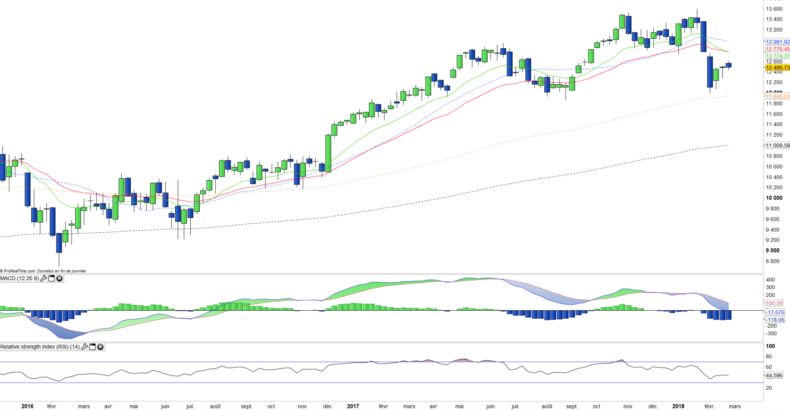DB X-Trackers (DBXD) - 28/02/2018
Short Term strategy : Negative (10%) / Trend -
Long Term strategy : Positive (70%) / Trend -
Characteristics of the ETF
The DBXD ETF (db x-trackers), quoted in Euro, replicates the DAX 30 index which is composed of the 30 largest listed German securities, representative of the main sectors of the economy, while the stocks are selected according to the importance of their market capitalization.
The costs of this ETF are low at 0.09% and AUM is quite high at 3922M €, which makes it one of the best vehicles in terms of costs / liquidity. The replication method is direct (physical) and the dividend distribution is capitalized.
Alternative ETFs: DAX (Lyxor in Euro), DAXEX (iShares in Euro)
Index & components
The top 10 stocks are mainly large industrial stocks such as Siemens or Bayer, while there are only 3 financial stocks: Allianz, Commerzbank and Deutsche Bank, the German master index is relatively small and mostly composed of large industrial groups.
Unlike the English, French or Italian indices, the DAX is also distinguished by the absence of large oil companies that weigh heavily in the weighting of the CAC40, FTSE100 or FTSEMIB40, which is double-edged according to the cycle specific to energy sector. In addition, the financials weigh only 16.9% of the index, half for the insurance giant Allianz, so the banking sector has a low weight reflected in the well-known weakness of Deutsche Bank and Commerzbank.
Conversely, the automotive and chemical sectors are heavier than the other European indices, while the technology sector is mainly represented by SAP (8,8%) whose market capitalization exceeds € 100 billion.
In summary, the DAX is a fairly strong index from a sectoral point of view which can make it evolve differently from other European indices. German fundamentals are very solid (GDP growth above 2%, historically low unemployment rate at 5.5% and accelerated deleveraging up to 2020).
The main risks concern Germany's main customers, namely the United Kingdom, which could suffer from Brexit, the US in political uncertainty and threatening it with a trade war, Russia which remains a difficult and aggressive neighbor and China because of its commercial practices which also tend to limit access to its domestic market to Western industrialists, particularly in the automotive and technology sectors.
Latest developments
After an increase of 6.9% in 2016, the DAX30 grew by 12.5% in 2017, more than the stoxx600 (+ 10.6%).
The index has fallen 3% since the beginning of the year after a sharp correction in the US markets, which is a lower performance than the Stoxx600NR (-1.3%). Despite a relative resistance of the automotive sector, the DAX has undergone a strong correction related to some key companies such as SAP (-9,2%), Siemens (-4,6%) or Deutsche Telekom (-8,6%) which is linked to profit taking supported in the wake of results T4 2017 in line with market expectations, no more.
The rise in German long-term rates has been very rapid, the 10-year rate has doubled in a few weeks and is currently stabilizing at 0.7%, a level that is still very low, but it is the speed of the rise that is worrying the markets. all the more so as wage tensions are increasing in Germany, due to the economic upturn and full employment which could have a negative impact on the margins of German companies.
A new coalition has been approved and a new government should be forthcoming very soon, which is positive news for Germany and for Europe by eliminating the uncertainty of the vacancy of power in Europe's leading economy.
Monthly data
The monthly chart shows that the long-term trend of the DAX remains bullish despite the sharp correction in February but it leaves traces. The trend momentum begins to be impacted which can be seen on technical oscillators that turn downward, without having yet triggered a signal like the MACD but show a sharp decline. It is possible that the trend will pause for a few months on these levels.
Weekly data
On the weekly chart, we can observe a fairly strong bearish start, which has given way to a rebound so far quite weak and that does not seem able to prevent the imminent bearish crossing of moving averages at 13 and 26 weeks. . A relapse seems likely in the coming weeks on the MME100, given the weakness of the rebound while all the oscillators are oriented downward.
ETF Objective
DBXD is a UCITS ETF in € which seeks to replicate the DAX Index (30 german companies)
Characteristics
| Inception date | 10/01/2007 |
| Expense ratio | 0,09% |
| Issuer | Lyxor |
| Benchmark | DAX30 index |
| Code/Ticker | DBXD |
| ISIN | LU0274211480 |
| UCITS | Yes |
| Currency | € |
| Exchange | XETRA |
| Assets Under Management | 3 920 M€ |
| Replication Method | Direct (Physical) |
| PEA (France) | No |
| SRD (France) | No |
| Dividend | Capitalization |
| Currency Risk | No |
| Number of Holdings | 30 |
| Risk | 3/5 |
Country Breakdown
| Germany | 100% |
Sector Breakdown
| Consumer Discretionary | 22% |
| Industrials | 19% |
| Financials | 16% |
| Health Care | 13% |
| Materials | 13% |
| Technology | 9% |
| Telecom | 6% |
| Others | 2% |
Top Ten Holdings
| Siemens | 9% |
| SAP | 9% |
| Bayer | 8% |
| BASF | 8% |
| Allianz | 8% |
| Daimler | 7% |
| Deutsche Telekom | 5% |
| Deutsche Post | 4% |
| Linde | 3% |
| Adidas | 3% |


